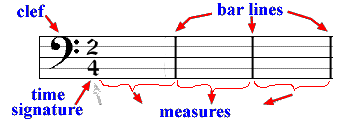
It's About Time!
As you have been learning in your theory lessons,
music contains a lot of counting! Now you're going to find out
how all the music symbols you've been working with "fit"
together.
Music is written on a staff and divided up into units called measures or bars. The lines that divide the music into measures are called bar lines. Look at this example to see what measures and bar lines look like on the staff:

In previous lessons, you learned that notes
and rests have certain lengths, or are worth a particular number
of beats. Well, each measure contains only a certain number of
beats. The composer tells us how many beats are in a measure with
another musical symbol called the time signature. In the example
above, the time signature is ![]() . You
would read such a time signature as "two-four". There
would be two beats in every measure of a song written with this
time signature. You can also have three, four, or more beats in
a measure. Let's take a closer look at what the numbers in a time
signature mean:
. You
would read such a time signature as "two-four". There
would be two beats in every measure of a song written with this
time signature. You can also have three, four, or more beats in
a measure. Let's take a closer look at what the numbers in a time
signature mean:
|
|
| 2 the top number tells us how many beats are in a
measure 4 the bottom number tells us what kind of note gets one beat |
In this lesson, we are only going to deal with three different time signatures:
,
, and
Remember: the top number of the time signature is how many beats there are in a measure. The first time signature would have two beats per measure, the second time signature would have three beats per measure, and the third time signature would have four beats per measure.
You will notice that all three of the time signatures shown above have the bottom number of '4'. That tells us what kind of note gets the beat. In this case, the bottom number means a quarter note will get one beat. It is possible to have a number other than four on the bottom of a time signature, though. For example: an "8" on the bottom would tell us that an eighth note would get one beat. A "2" on the bottom would tell us that a half note would get one beat. There are many different combinations of numbers that can make up a time signature. As you have probably figured out by now, a musician must know the time signature of a piece in order to play the notes the proper length.
Recommended Internet Reading
Explore the facts about Counting Time.
|
Music Theory Lessons |
Some music images used with permission of
SKDesigns
copyright © 1996-1999